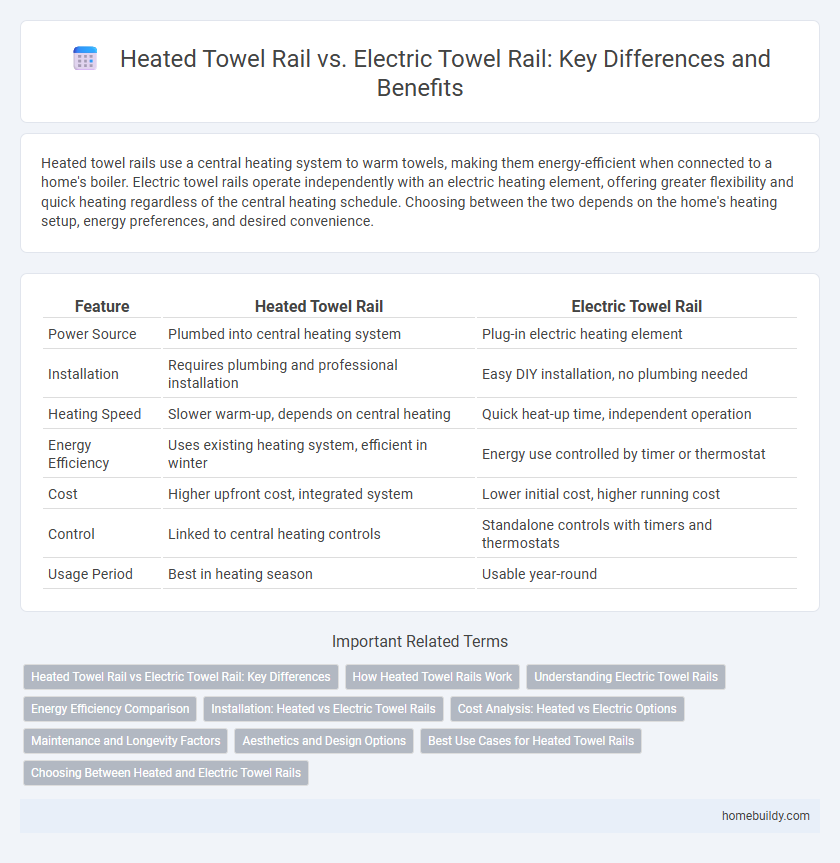Heated towel rails use a central heating system to warm towels, making them energy-efficient when connected to a home's boiler. Electric towel rails operate independently with an electric heating element, offering greater flexibility and quick heating regardless of the central heating schedule. Choosing between the two depends on the home's heating setup, energy preferences, and desired convenience.
Table of Comparison
| Feature | Heated Towel Rail | Electric Towel Rail |
|---|---|---|
| Power Source | Plumbed into central heating system | Plug-in electric heating element |
| Installation | Requires plumbing and professional installation | Easy DIY installation, no plumbing needed |
| Heating Speed | Slower warm-up, depends on central heating | Quick heat-up time, independent operation |
| Energy Efficiency | Uses existing heating system, efficient in winter | Energy use controlled by timer or thermostat |
| Cost | Higher upfront cost, integrated system | Lower initial cost, higher running cost |
| Control | Linked to central heating controls | Standalone controls with timers and thermostats |
| Usage Period | Best in heating season | Usable year-round |
Heated Towel Rail vs Electric Towel Rail: Key Differences
Heated towel rails typically use hot water from a central heating system to warm towels, offering energy-efficient and consistent heat, while electric towel rails rely on an internal electric heating element, providing quicker warm-up times and independent operation from the central heating. Heated towel rails are ideal for homes with existing wet heating systems, whereas electric towel rails suit spaces without central heating or where zoned heating control is preferred. The choice between heated and electric towel rails depends on installation feasibility, energy costs, and user convenience.
How Heated Towel Rails Work
Heated towel rails use central heating systems to warm the metal bars through hot water circulation, efficiently transferring heat to towels and the bathroom environment. Electric towel rails operate independently by converting electrical energy into heat via built-in heating elements, allowing flexible installation without connection to central heating. Both types provide consistent warmth and enhanced drying, but heated towel rails rely on home heating infrastructure, while electric versions offer customizable temperature control and energy efficiency.
Understanding Electric Towel Rails
Electric towel rails use an integrated heating element powered by electricity to warm towels efficiently and maintain a consistent temperature, making them ideal for quick heating and energy control. Unlike traditional heated towel rails that rely on central heating systems, electric variants operate independently, offering flexibility in installation and use throughout the year. This distinction allows electric towel rails to provide targeted warmth, improve bathroom comfort, and reduce dependency on household heating schedules.
Energy Efficiency Comparison
Heated towel rails, often connected to central heating systems, typically use less electricity by utilizing existing heat sources, making them more energy-efficient for homes with central heating. Electric towel rails operate independently using electric resistance, offering quick heating but generally consuming more electricity over time. Choosing between the two depends on the home's heating infrastructure and energy consumption preferences, with heated towel rails being more cost-effective for multi-season use.
Installation: Heated vs Electric Towel Rails
Heated towel rails typically require connection to the central heating system, making installation more complex and often necessitating a professional plumber. Electric towel rails operate independently through a standard electrical outlet or hardwiring, allowing for easier, more flexible installation without modifying existing plumbing. Choosing between the two depends on existing infrastructure and installation convenience, with electric models offering straightforward setup in both new builds and renovations.
Cost Analysis: Heated vs Electric Options
Heated towel rails typically incur higher initial installation costs due to connection to central heating systems, whereas electric towel rails offer lower upfront expenses with simple plug-in options. Operating costs vary as heated rails use existing boiler energy, making them cost-effective during heating seasons, while electric rails consume standalone electricity, potentially increasing energy bills. Long-term expenses depend on household heating preferences, energy prices, and frequency of towel warmer use.
Maintenance and Longevity Factors
Heated towel rails, typically connected to the central heating system, require regular flushing and bleeding to prevent corrosion and maintain efficient heat transfer, extending their lifespan. Electric towel rails demand less maintenance but need periodic electrical inspections to ensure safety and optimal functionality. Both types benefit from corrosion-resistant materials like stainless steel or aluminum, which significantly enhance durability and longevity.
Aesthetics and Design Options
Heated towel rails often feature a sleek, minimalist design that seamlessly integrates with modern bathroom aesthetics, offering a variety of finishes such as chrome, matte black, and brushed nickel to complement different decor styles. Electric towel rails provide greater flexibility in design options, including programmable timers and adjustable heat settings, which enhance both functionality and visual appeal. The choice between heated and electric towel rails ultimately depends on the desired balance between traditional radiator styling and contemporary, tech-driven customization.
Best Use Cases for Heated Towel Rails
Heated towel rails are ideal for maintaining a consistent, gentle warmth in bathrooms with existing central heating systems, providing energy-efficient warmth by connecting to the hot water circuit. They excel in homes where prolonged heat retention for towels and ambient room heating is desired, ensuring towels are dry and cozy throughout the day. Electric towel rails, while convenient for standalone use, are best suited for spaces without central heating or for supplemental, quick heat.
Choosing Between Heated and Electric Towel Rails
When choosing between heated towel rails and electric towel rails, consider the room's existing heating system and installation complexity; heated towel rails connect to central heating for consistent warmth, while electric models operate independently using an internal heating element. Electric towel rails offer flexibility with programmable timers and temperature control, making them ideal for bathrooms without central heating. Energy efficiency, cost, and user convenience are key factors influencing the decision between these two popular options.
Heated towel rail vs electric towel rail Infographic

 homebuildy.com
homebuildy.com